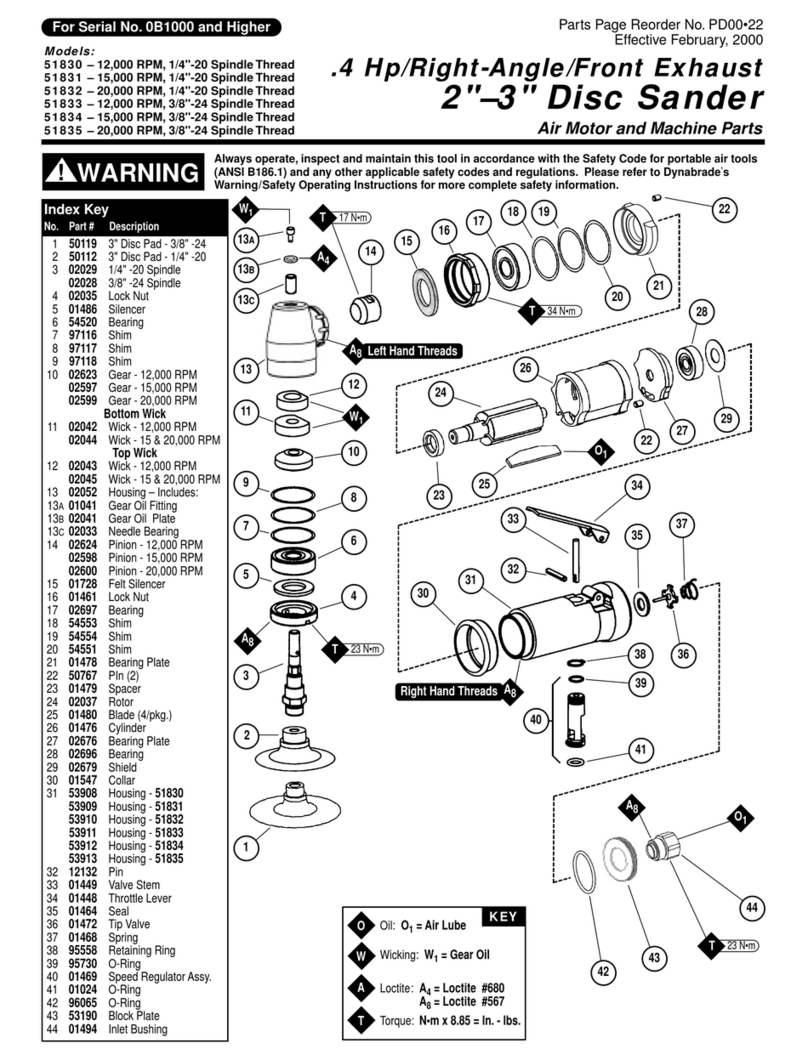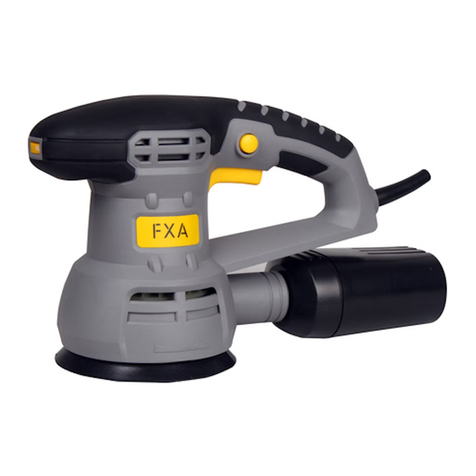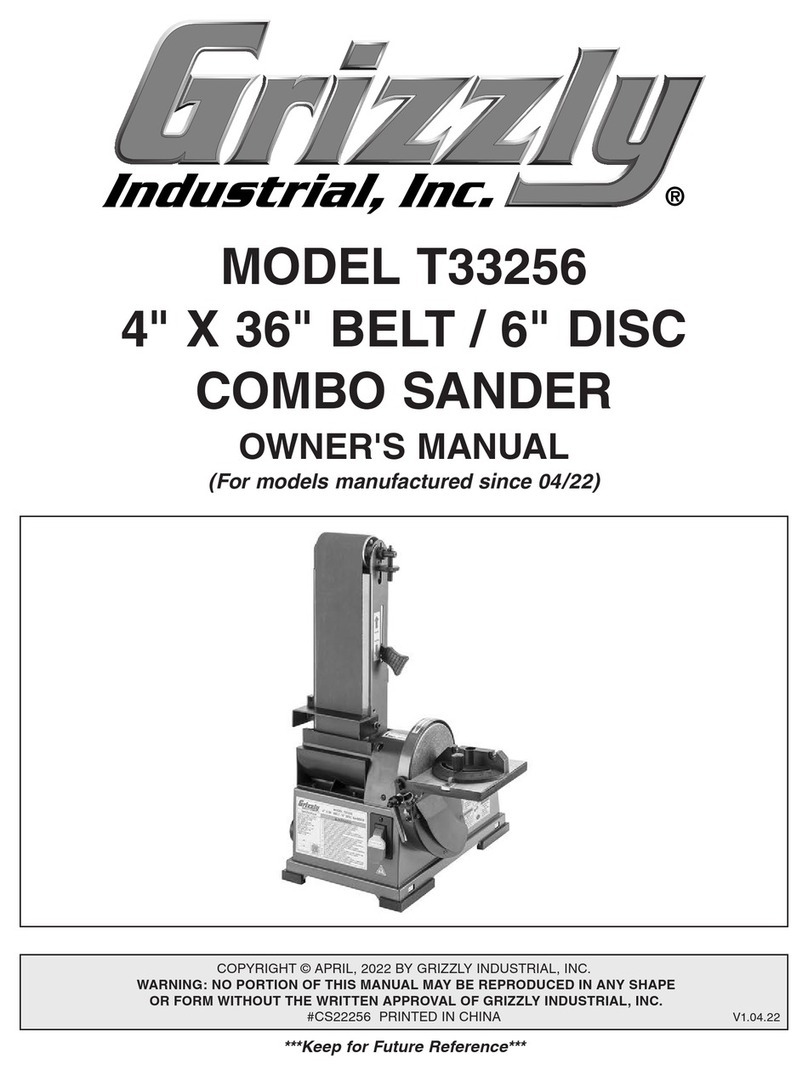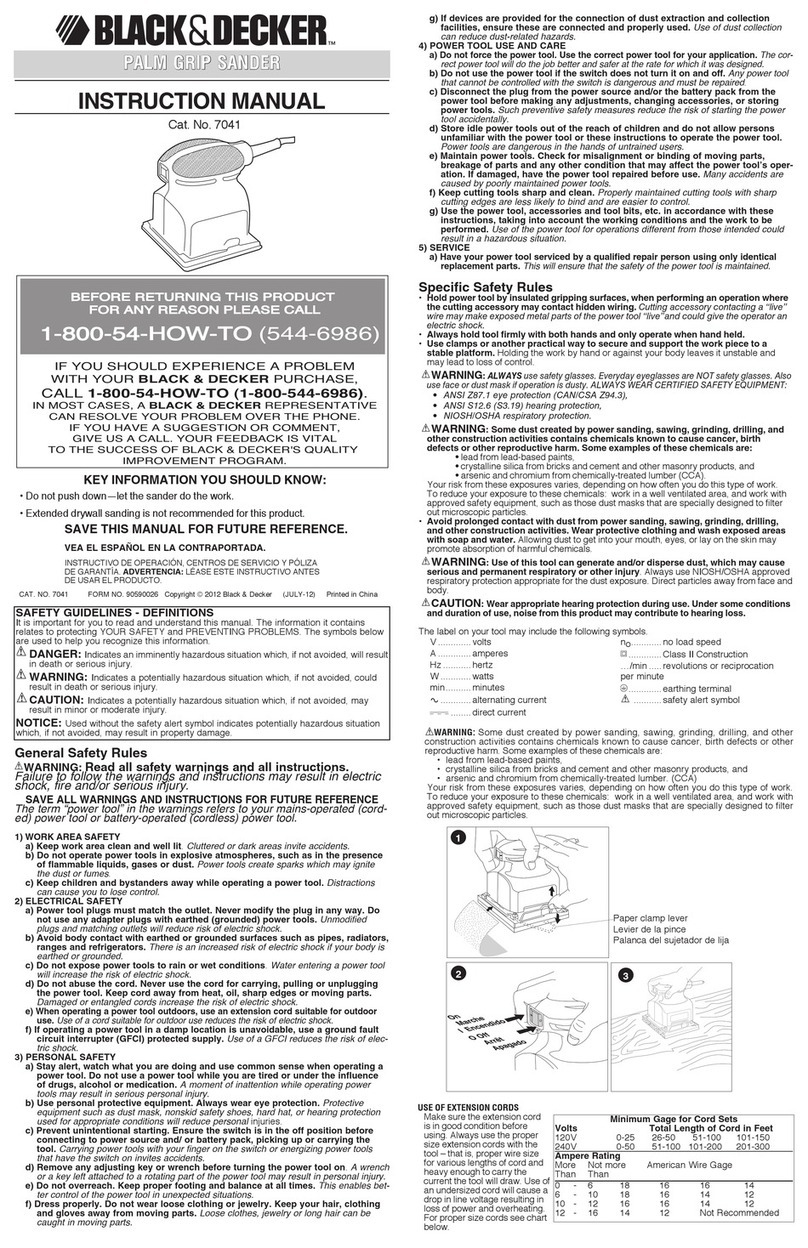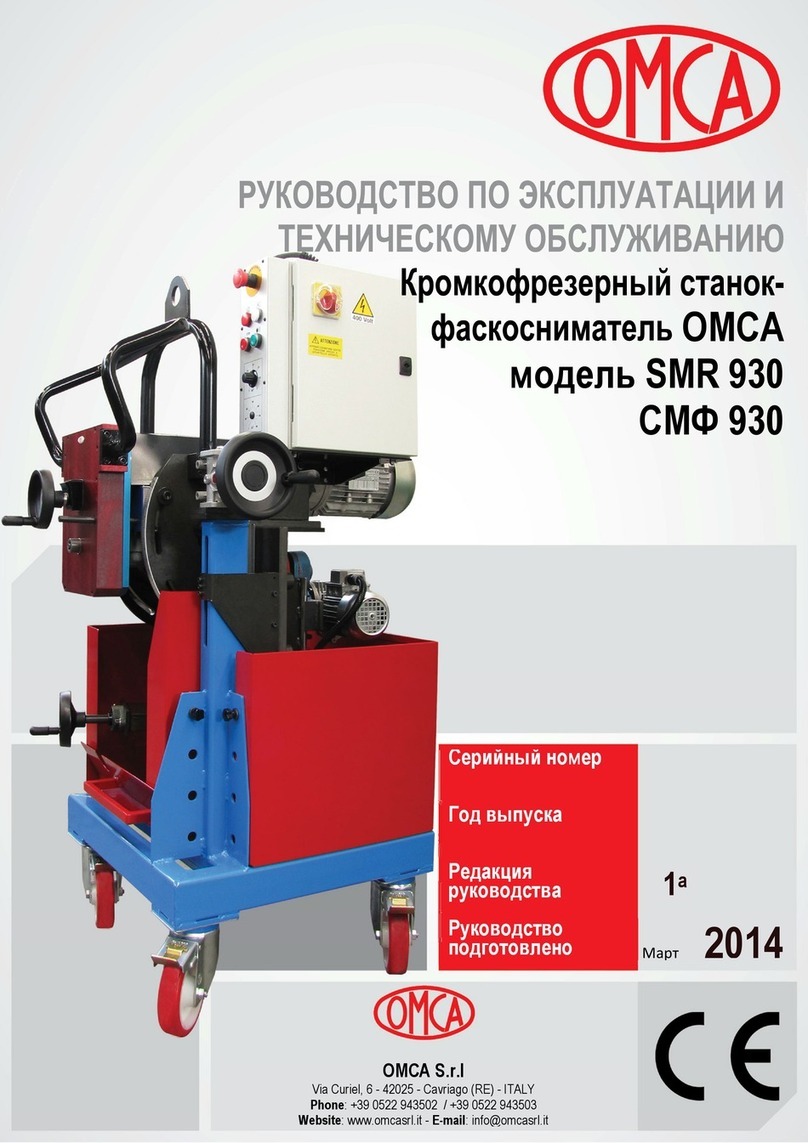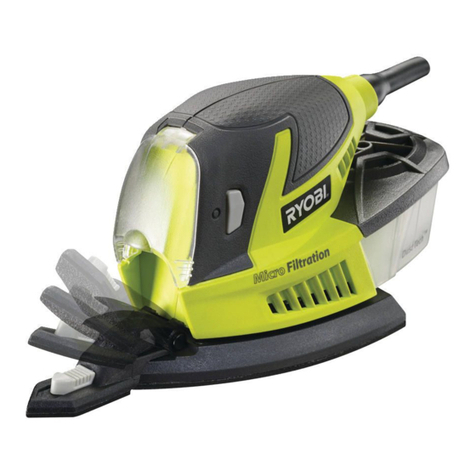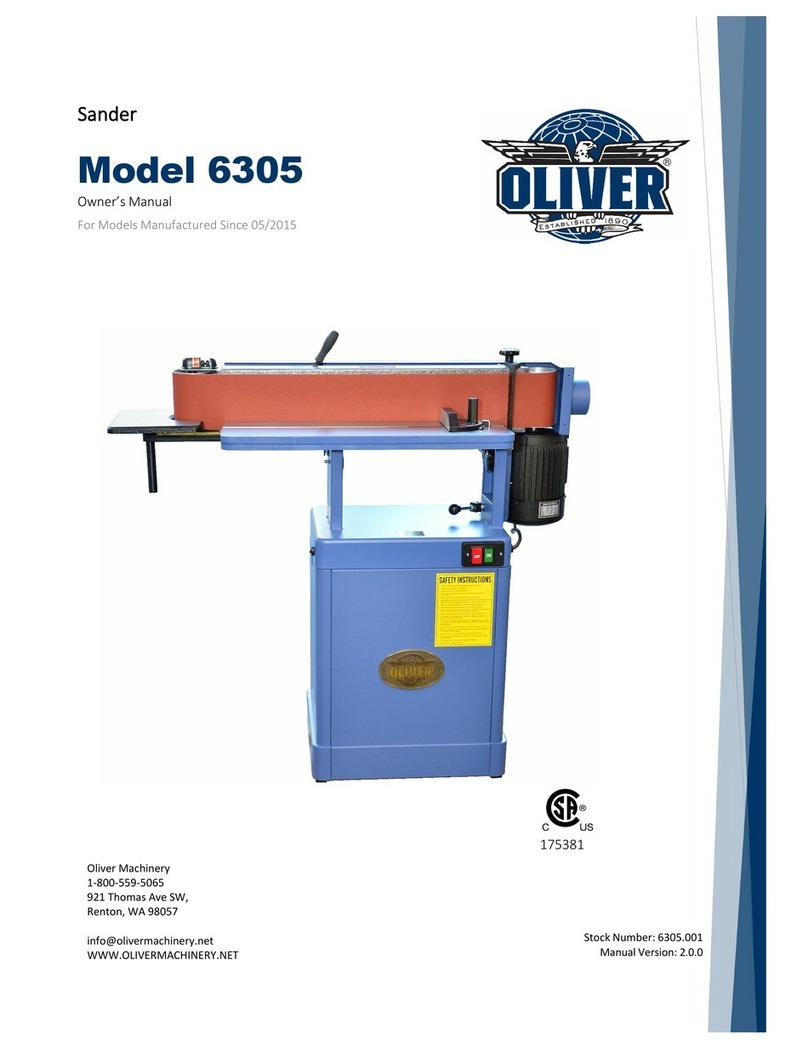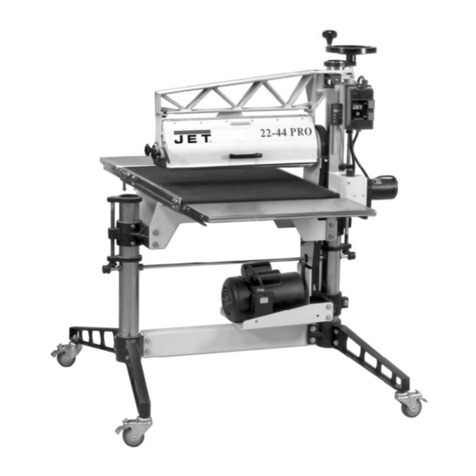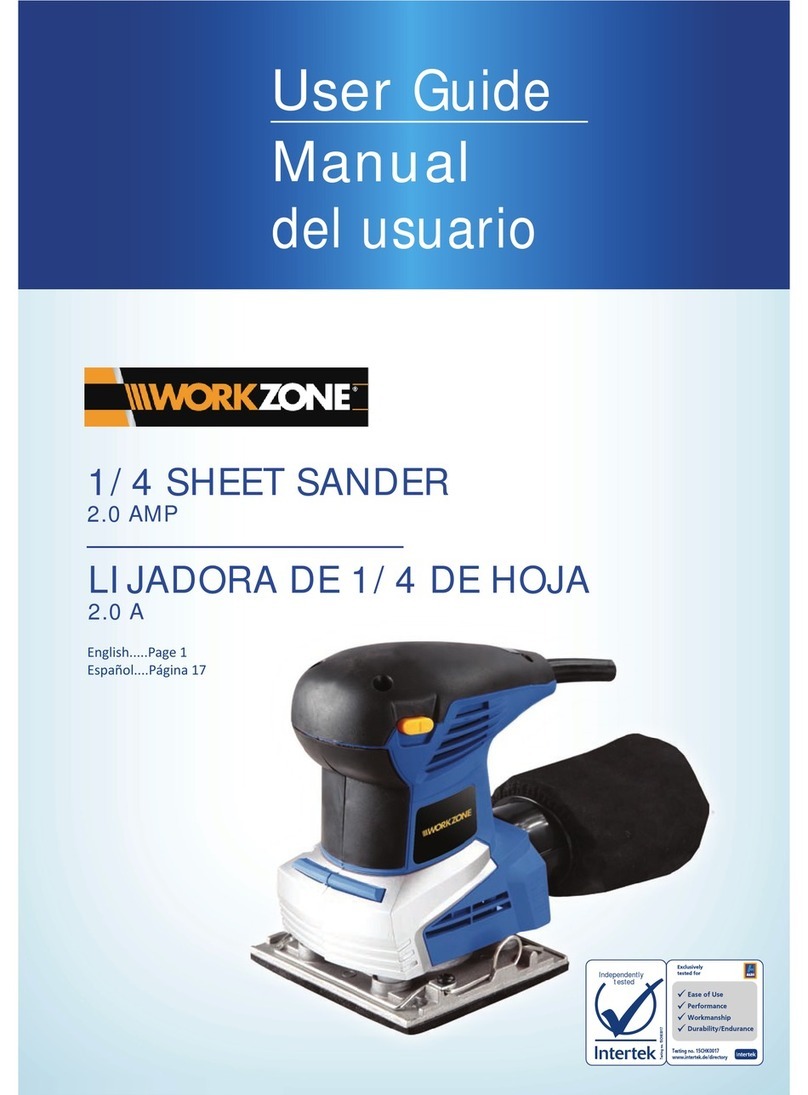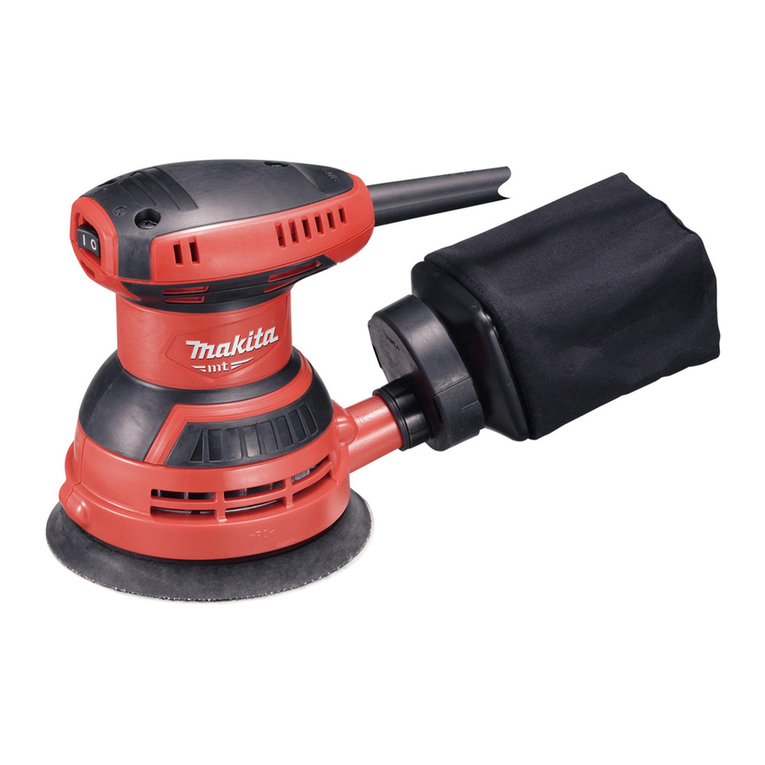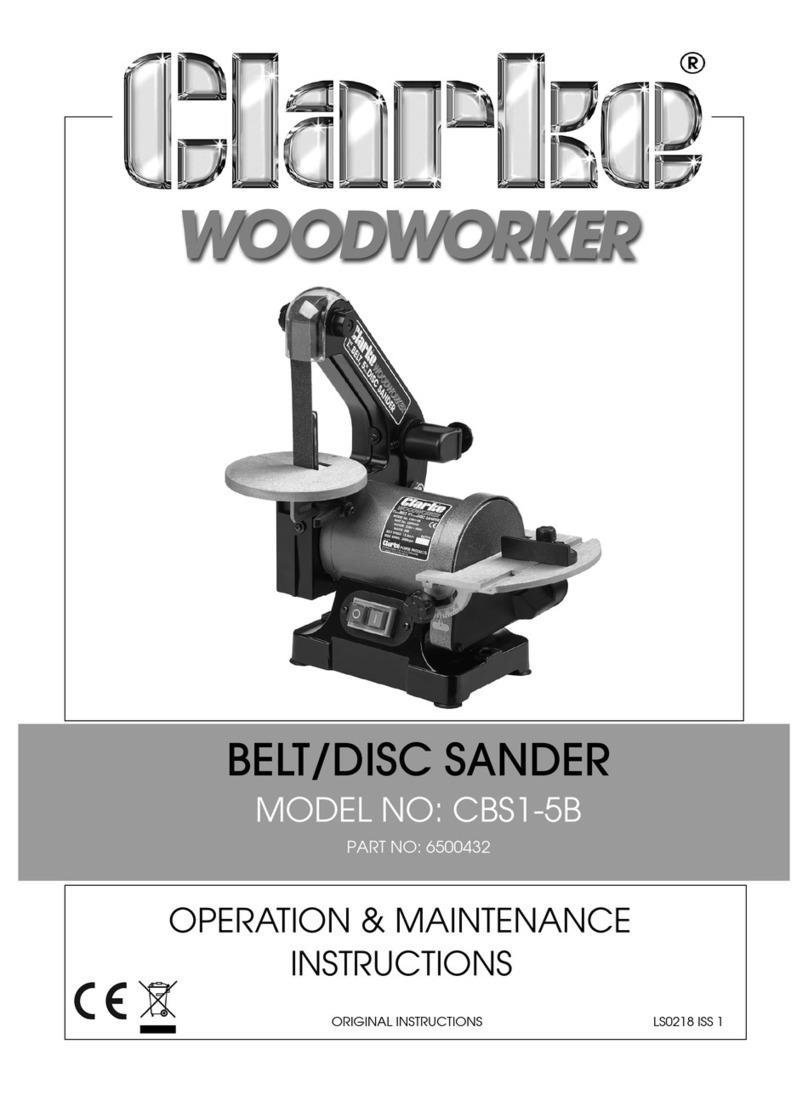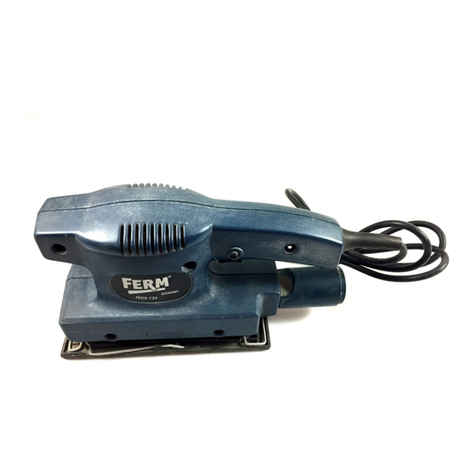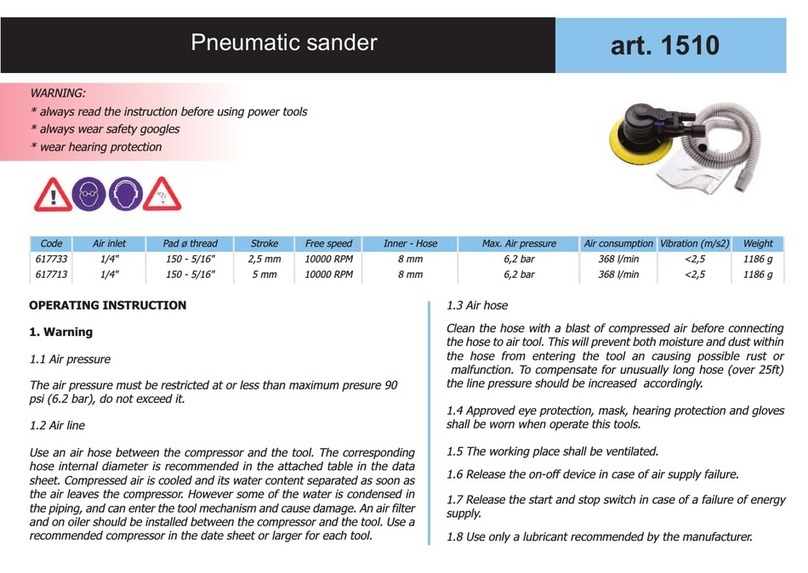Hitachi Koki FSV 10SA User manual

FSV 10SA
Orbital Sander
Schwingschleifer
Ponceuse orbitale
Levigatrice orbitale
Vlakschuurmachine
Lijadora orbital
Lixadeira orbital
¶·ÏÌÈÎfi ÙÚȂ›Ô
Read through carefully and understand these instructions before use.
Diese Anleitung vor Benutzung des Werkzeugs sorgfältig durchlesen und verstehen.
Lire soigneusement et bien assimiler ces instructions avant usage.
Prima dell’uso leggere attentamente e comprendere queste istruzioni.
Deze gebruiksaanwijzing s.v.p. voor gebruik zorgvuldig doorlezen.
Leer cuidadosamente y comprender estas instrucciones antes del uso.
Antes de usar, leia com cuidado para assimilar estas instruções.
∆ιαβάστε προσεκτικά και κατανοήσετε αυτές τις οδηγίες πριν τη χρήση.
Handling instructions
Bedienungsanleitung
Mode d’emploi
Istruzioni per l’uso
Gebruiksaanwijzing
Instrucciones de manejo
Instruções de uso
Οδηγίες χειρισµού

1
12
4
3
56
1
2
3
45
6
87
A
B
184 mm
230 mm
280 mm

2
English Deutsch Français Italiano
1
2
3
4
5
6
7
8
Fold
Paper holder
Bend
Dust bag clamp
Dust gate
Dust bag
Punch plate
Guide
Falz
Papierhalter
Knick
Staubsackklemme
Staubausgang
Staubsack
Stanzplatte
Führung
Pli
Support du papier
Coude
Elément de serrage du
sac à poussière
Volet à poussière
Sac à poussière
Plaque de poiçonnage
Guide
Piega
Fermacarta
Curva
Morsetto per sacca di
raccolta della polvere
Uscita polvere
Sacca di raccolta della
polvere
Punzone
Guida
Nederlands Español Português Ελληνικά
1
2
3
4
5
6
7
8
Vouw
Papierhouder
Buiging
Stofzakklem
Stofschuif
Stofzak
Doorslagplaat
Geleider
Pliego
Sujección de papel
Curva
Abrazadera de bolsa de
polvo
Boca de salida del
serrín
Bolsa celector de polvo
Placa perforadora
Guía
Dobra
Suporte de papel
Dobrar
Grampo do saco do pó
Boca de saída da poeira
Bolsa coletora de poeira
Placa perfuradora
Guia
∆ιπλώστε
Εξάρτηµα συγκράτησης
χαρτιού
Λυγίστε
Σφιγκτήρας σάκου
σκνης
Είσοδος σκνης
Σάκος σκνης
Πλάκα διατρύπησης
Οδηγς

3
English
GENERAL SAFETY RULES
WARNING!
Read all instructions
Failure to follow all instructions listed below may result in
electric shock, fire and/or serious injury.
The term “power tool” in all of the warnings listed below
referstoyourmainsoperated(corded)powertoolorbattery
operated (cordless) power tool.
SAVE THESE INSTRUCTIONS
1) Work area
a) Keep work area clean and well lit.
Cluttered and dark areas invite accidents.
b) Do not operate power tools in explosive
atmospheres, such as in the presence of flammable
liquids, gases or dust.
Powertoolscreate sparks whichmayignite the dust
of fumes.
c) Keepchildrenandbystandersawaywhileoperating
a power tool.
Distractions can cause you to lose control.
2) Electrical safety
a) Power tool plugs must match the outlet.
Never modify the plug in any way.
Do not use any adapter plugs with earthed
(grounded) power tools.
Unmodified plugs and matching outlets will reduce
risk of electric shock.
b) Avoid body contact with earthed or grounded
surfaces such as pipes, radiators, ranges and
refrigerators.
There is an increased risk of electric shock if your
body is earthed or grounded.
c) Donotexposepowertoolstorainor wet conditions.
Water entering a power tool will increase the risk of
electric shock.
d) Do not abuse the cord. Never use the cord for
carrying, pulling or unplugging the power tool.
Keep cord away from heat, oil, sharp edges or
moving parts.
Damaged or entangled cords increase the risk of
electric shock.
e) When operating a power tool outdoors, use an
extension cord suitable for outdoor use.
Use of a cord suitable for outdoor use reduces the
risk of electric shock
3) Personal safety
a) Stay alert, watch what you are doing and use
common sense when operating a power tool.
Do not use a power tool while you are tired or
undertheinfluenceofdrugs, alcohol or medication.
A moment of inattention while operating power
tools may result in serious personal injury.
b) Usesafetyequipment.Alwaysweareyeprotection.
Safetyequipment suchasdustmask,non-skidsafety
shoes, hard hat, or hearing protection used for
appropriateconditionswillreducepersonalinjuries.
c) Avoid accidental starting. Ensure the switch is in
the off position before plugging in.
Carrying power tools with your finger on the switch
or plugging in power tools that have the switch on
invites accidents.
d) Removeanyadjusting key or wrench before turning
the power tool on.
A wrench or a key left attached to a rotating part of
the power tool may result in personal injury.
e) Do not overreach. Keep proper footing and balance
at all times.
This enables better control of the power tool in
unexpected situations.
f) Dress properly. Do not wear loose clothing or
jewellery.Keepyourhair, clothing and gloves away
from moving parts.
Loose clothes, jewellery or long hair can be caught
in moving parts.
g) If devices are provided for the connection of dust
extraction and collection facilities, ensure these are
connected and properly used.
Useofthesedevicescanreducedustrelatedhazards.
4) Power tool use and care
a) Do not force the power tool. Use the correct power
tool for your application.
The correct power tool will do the job better and
safer at the rate for which it was designed.
b) Do not use the power tool if the switch does not
turn it on and off.
Any power tool that cannot be controlled with the
switch is dangerous and must be repaired.
c) Disconnect the plug from the power source before
making any adjustments, changing accessories, or
storing power tools.
Such preventive safety measures reduce the risk of
starting the power tool accidentally.
d) Store idle power tools out of the reach of children
anddonot allow persons unfamiliar with the power
tool or these instructions to operate the power
tool.
Powertoolsaredangerousinthehandsofuntrained
users.
e) Maintain power tools. Check for misalignment or
binding of moving parts, breakage of parts and any
other condition that may affect the power tools
operation.
If damaged, have the power tool repaired before
use.
Many accidents are caused by poorly maintained
power tools.
f) Keep cutting tools sharp and clean.
Properlymaintainedcuttingtoolswithsharp cutting
edgesarelesslikelytobindandareeasiertocontrol.
g) Use the power tool, accessories and tool bits etc.,
in accordance with these instructions and in the
manner intended for the particular type of power
tool, taking into account the working conditions
and the work to be performed.
Use of the power tool for operations different from
intended could result in a hazardous situation.
5) Service
a) Have your power tool serviced by a qualified repair
person using only identical replacement parts.
This will ensure that the safety of the power tool is
maintained.
PRECAUTION
Keep children and infirm persons away.
When not in use, tools should be stored out of reach of
children and infirm persons.

4
English
*Be sure to check the nameplate on product as it is subject to change by areas.
SPECIFICATIONS
Voltage (by areas)* (110V, 115V, 120V, 127V, 220V, 230V, 240V)
Power Input 180W*
No-load speed 10000 min–1
Sanding pad size 92 mm ×184 mm
Sanding paper size 93 mm ×228 mm
Weight (without cord) 1.3 kg
STANDARD ACCESSORIES
䡬Sanding paper ............................................................6
(Grain: #60, #100, #150.....................................2 each)
䡬Dust bag ......................................................................1
䡬Punch plate .................................................................1
Standard accessories are subject to change without
notice.
OPTIONAL ACCESSORIES (sold separately)
1. Sanding paper
Grain: #60, #100, #150 (3 types)
2. Sanding paper (Magic type)
Grain: #60, #100, #150 (3 types)
3. Pad (Magic type)
Optionalaccessoriesare subject tochangewithout notice.
APPLICATIONS
䡬Finish polishing of woodwork surfaces
䡬Sanding surfaces of woodwork or sheet metal prior
to painting, etc.
PRIOR TO OPERATION
1. Power source
Ensure that the power source to be utilized conforms
to the power requirements specified on the product
nameplate.
2. Power switch
Ensure that the power switch is in the OFF positon. If
the plug is connected to a receptacle while the power
switch is in the ON position, the power tool will start
operating immediately, which could cause a serious
accident.
3. Extension cord
When the work area is removed from the power
source, use an extension cord of sufficient thickness
and rated capacity. The extension cord should be
kept as short as practicable.
4. Installing the sanding paper
Align the hole in the base with the sanding paper
holes. Place the sanding paper over the base. Next
line up both ends of the sanding paper with the base
width-wise, and fold the sanding paper (Fig. 1).
Align the fold with the edge of the base, and grip one
side with the paper holder (Fig. 2).
Now grip the opposite side of the sanding paper with
the paper holder.
CAUTION
The sanding paper must be precisely installed on the
pad, ensuring that there is ample tension (leaving no
slack). Loosely installed sanding paper could result
in unevenly sanded surfaces and/or damage to the
sanding paper itself.
5. Attaching and Removing the Dust Bag
(1) Attaching the Dust Bag
As shown in Fig. 3, hold the dust gate and push it in
the direction of Arrow A to attach it to the dust outlet.
(2) Removing the Dust Bag
As shown in Fig. 3, hold the dust gate and pull it in
the direction of Arrow B to remove it from the dust
outlet.
CAUTION
Priorto the sanding operation, makesure thematerial
of surface you are going to sand.
If the surface under sanding operation is expected to
generate harmful / toxic dusts such as lead painted
surface, make sure the dust bag or appropriate dust
extractionsystemis connected withdustoutlet tightly.
Wear the dust mask additionally, if available.
Do not inhale or touch the harmful / toxic dusts
generated in sanding operation, the dust can
endanger the health of yourself and bystanders.
PRACTICAL OPERATING PROCEDURES
CAUTION
Never apply water or grinding fluid when sanding.
This could result in electrical shock.
1. Switching the sander ON and OFF
The power can be turned on by setting the lever to
ON (1) and turned off by setting the lever to OFF (0).
CAUTION
Never turn the power switch ON when the sander is
contactingthe surfaceto be sanded. This isnecessary
topreclude damageto the material. The sameapplies
when switching the power OFF.
2. How to hold the orbital sander
While gripping the housing, lightly press the sander
against the surface to be sanded so that the sanding
paper uniformly contacts the surface, as shown in
Fig. 4.DO NOTapplyexcessive pressureto the sander
while sanding. Excessive-pressure may cause
overload of the motor, reduced service life of the
sanding paper, and lowered sanding or polishing
efficiency.
3. How to move the orbital sander
For optimum operating efficiency, alternately move
thesander forwardand backwardat aconstant speed
and balance.
Table of contents
Languages:
Other Hitachi Koki Sander manuals
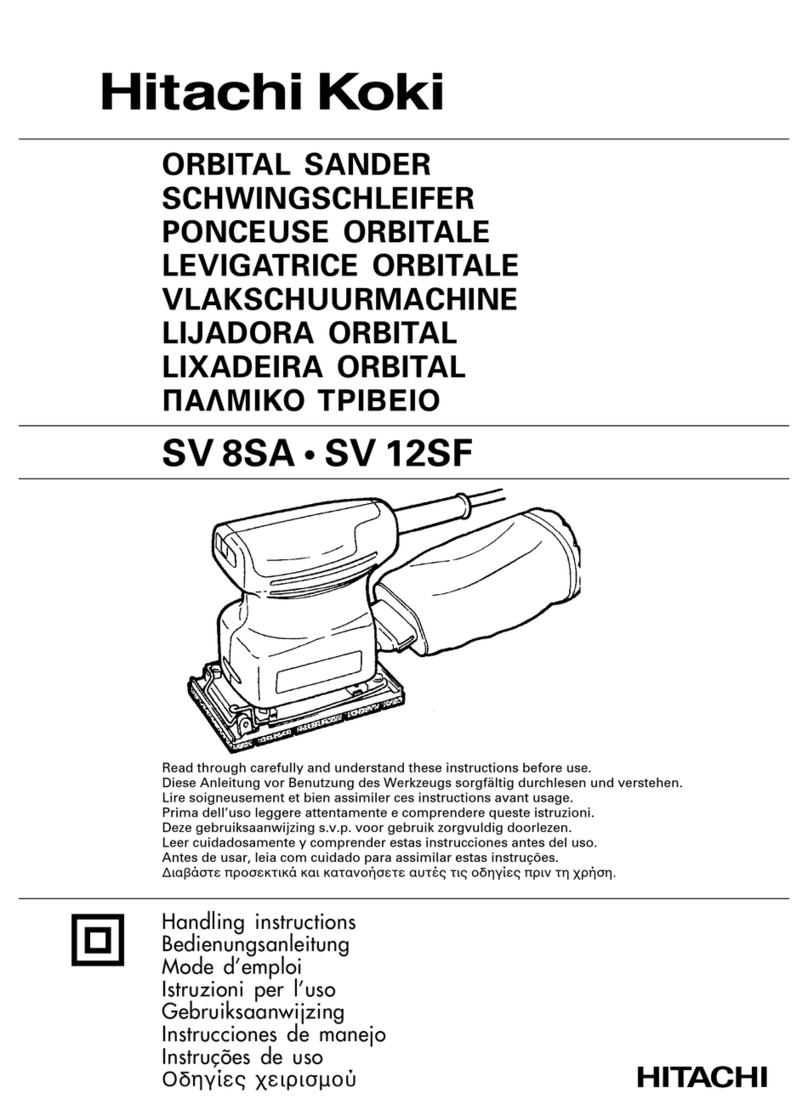
Hitachi Koki
Hitachi Koki SV 8SA User manual

Hitachi Koki
Hitachi Koki SV 12SH User manual
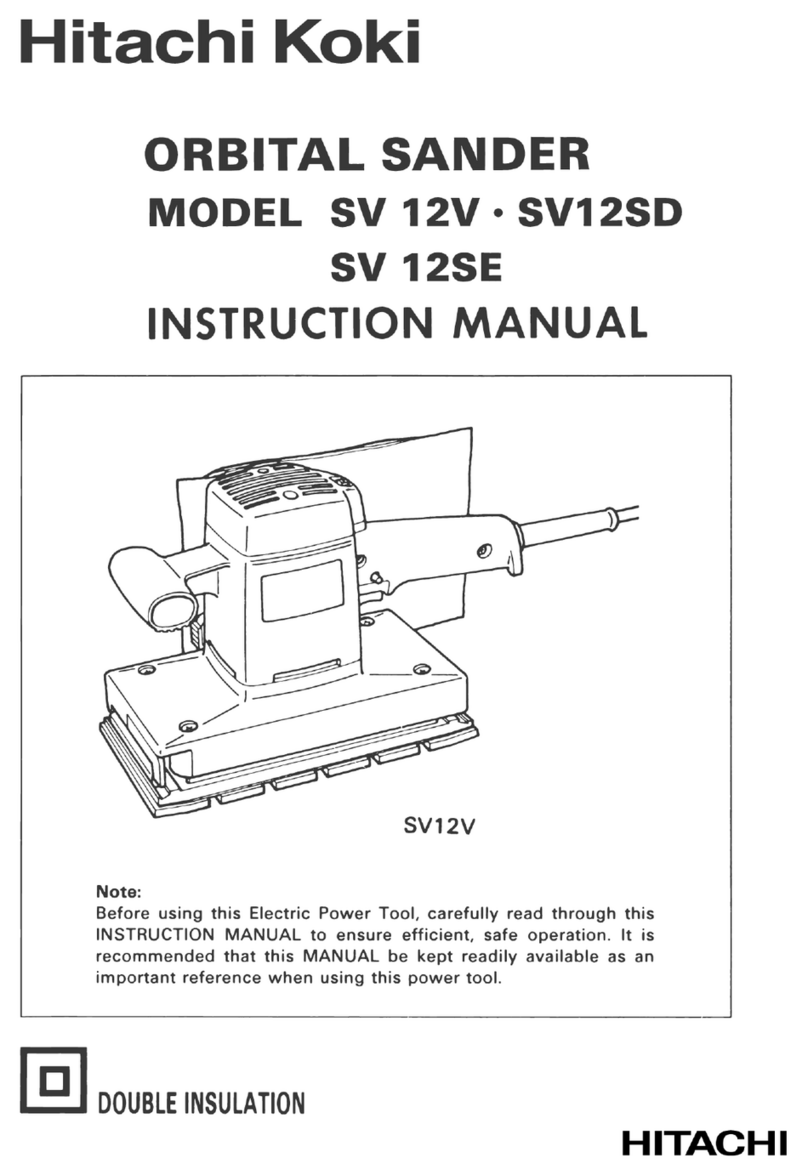
Hitachi Koki
Hitachi Koki SV 12V User manual
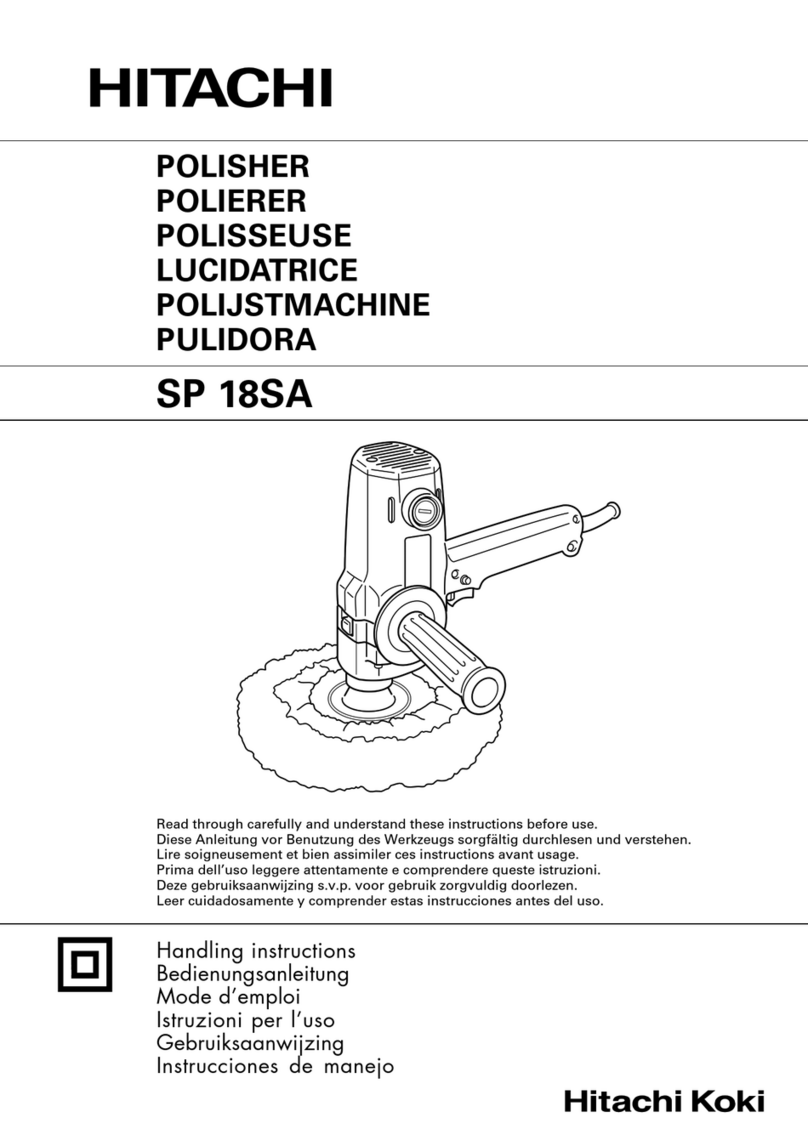
Hitachi Koki
Hitachi Koki SP 18SA User manual

Hitachi Koki
Hitachi Koki SV 12SG User manual
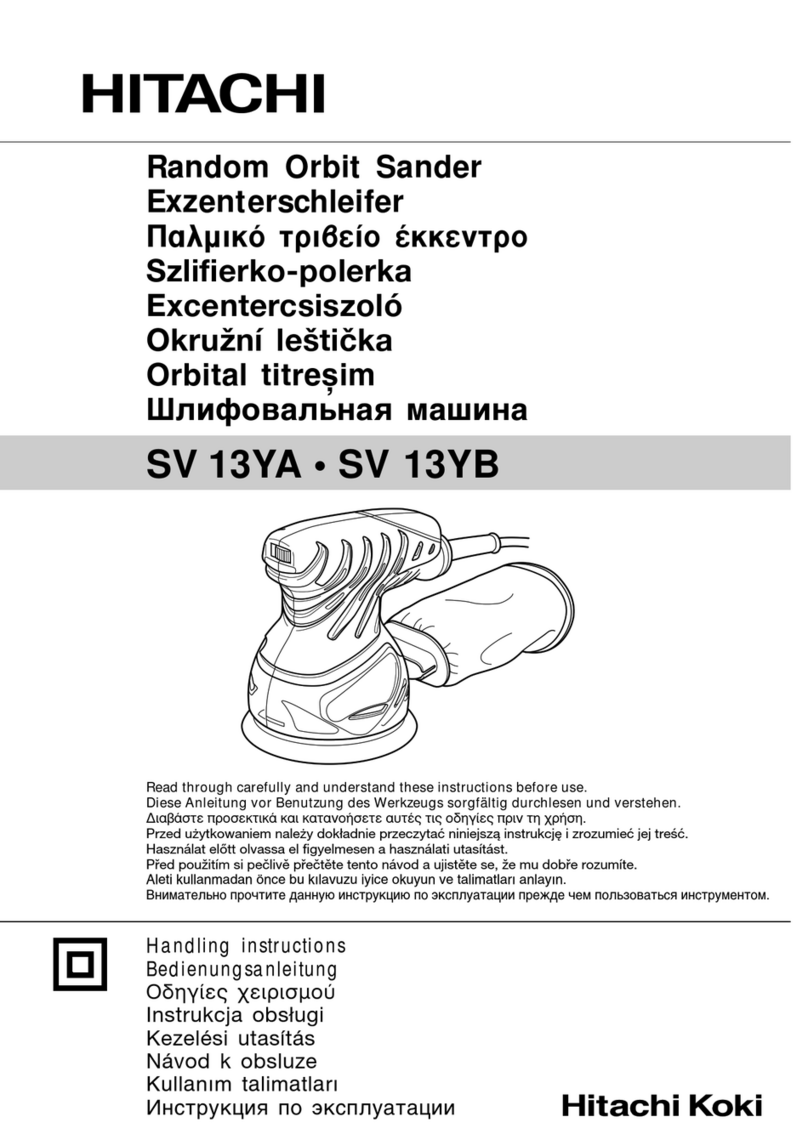
Hitachi Koki
Hitachi Koki SV 13YB User manual

Hitachi Koki
Hitachi Koki SV 12SH User manual
